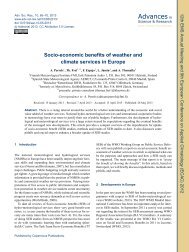Assessing components of the natural environment of the Upper ...
Assessing components of the natural environment of the Upper ...
Assessing components of the natural environment of the Upper ...
You also want an ePaper? Increase the reach of your titles
YUMPU automatically turns print PDFs into web optimized ePapers that Google loves.
32 S. Lang et al.: <strong>Assessing</strong> <strong>components</strong> <strong>of</strong> <strong>the</strong> <strong>natural</strong> <strong>environment</strong><br />
Table 7. Hydrological classes based on <strong>the</strong> hydrological dynamics <strong>of</strong> <strong>the</strong> different wetlands (Keddy, 2000).<br />
Hydrological class Description Wetland class<br />
Flooding<br />
Groundwater<br />
Hybrid<br />
Slope<br />
wetlands depending mainly on flooding and inundation<br />
with sediment rich run<strong>of</strong>f from <strong>the</strong> river<br />
wetlands depending on groundwater dynamics with<br />
seasonal rise and falling <strong>of</strong> groundwater<br />
wetlands <strong>of</strong> a hybrid nature comprising flooding and<br />
groundwater<br />
wetlands at footslopes fed by interflow from <strong>the</strong><br />
adjacent slopes<br />
alluvials, floodplains, beels<br />
lakes, swamps<br />
beels, lakes<br />
swamps, meadows<br />
Figure 9. Assam – aquifer vulnerability based on DRASTIC IN-<br />
DEX value.<br />
into four hydrological classes by <strong>the</strong>ir hydrological dynamics<br />
(Table 7).<br />
In <strong>the</strong> Syn<strong>the</strong>sis Report Wetland and Water (Millennium<br />
Ecosystem Assessment, 2005) <strong>the</strong> relative magnitude [low<br />
(·) – medium (•) – high ()] <strong>of</strong> wetland-based ecosystem<br />
services is based on expert opinion, and provides a general<br />
pattern for wetland classification in a global scale. This<br />
framework was adapted for <strong>the</strong> wetland classes found in <strong>the</strong><br />
BRAHMATWINN twinning basins at sub-catchment scale.<br />
The assessment was conducted using <strong>the</strong> information from<br />
local data which was collected during field trips in <strong>the</strong> respective<br />
Sub-catchments in Tibet, Assam and Bhutan, and<br />
through <strong>the</strong> evaluation <strong>of</strong> wetland databases (Ramsar Site Information<br />
Service, Global Wetland Inventory Database, Wetlands<br />
<strong>of</strong> India and European Environmental Agency). The<br />
median <strong>of</strong> <strong>the</strong> values <strong>of</strong> <strong>the</strong> following ecosystem services<br />
was used to assess <strong>the</strong> biodiversity <strong>of</strong> <strong>the</strong> wetlands which are<br />
refugia, biological control, pollination and genetic/medicinal<br />
resources.<br />
Vulnerability <strong>of</strong> <strong>the</strong> wetlands was assessed particularly<br />
with regard to (I) <strong>the</strong> pressure <strong>of</strong> <strong>the</strong> adjacent human population<br />
on wetlands and to (II) <strong>the</strong> possible effects <strong>of</strong> climate<br />
Figure 10. Lhasa sub-catchment: Wetland classes (top); Wetland<br />
area (left) and polygons (right).<br />
change on <strong>the</strong> wetland distribution. Threat caused by density<br />
<strong>of</strong> settlements was partly derived from population-data<br />
provided by project partners working on socio-economic aspects.<br />
In <strong>the</strong> sub-basins <strong>of</strong> <strong>the</strong> twinning rivers characteristic locations<br />
with a potential <strong>of</strong> supporting wetlands were assessed<br />
on <strong>the</strong> basis <strong>of</strong> different sources: information available to<br />
<strong>the</strong> public as well as provided by project partners, using<br />
a geo-statistical approach based on expert opinion, hydrological<br />
data and inclination information derived from digital<br />
elevation information. Hydrological information was also<br />
used to determine vulnerability <strong>of</strong> wetlands on a general level<br />
(Fig. 10).<br />
Adv. Sci. Res., 7, 21–36, 2011<br />
www.adv-sci-res.net/7/21/2011/



